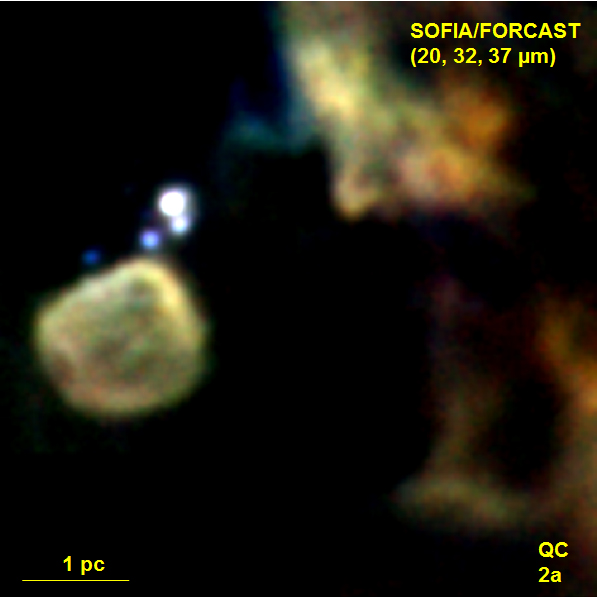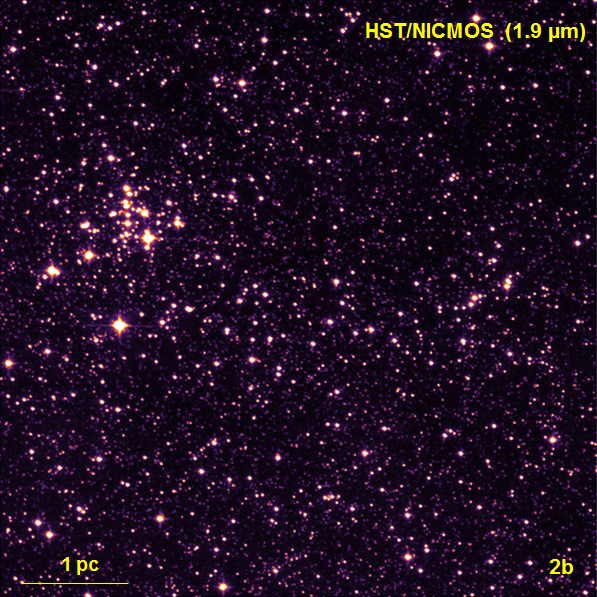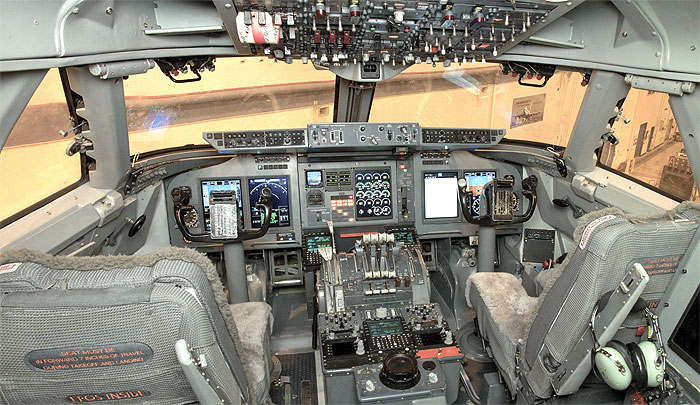.
SOFIA Spots Recent Starbursts in the Milky Way Galaxy's Center
WASHINGTON -- Researchers using the Stratospheric Observatory for Infrared Astronomy (SOFIA) have captured new images of a ring of gas and dust seven light-years in diameter surrounding the supermassive black hole at the center of the Milky Way, and of a neighboring cluster of extremely luminous young stars embedded in dust cocoons.
The images of our galaxy's circumnuclear ring (CNR) and its neighboring quintuplet cluster (QC) are the subjects of two posters presented this week during the American Astronomical Society's meeting in Long Beach, Calif. Ryan Lau of Cornell University and his collaborators studied the CNR. Matt Hankins of the University of Central Arkansas in Conway is lead author of the other paper, regarding the QC.
SOFIA is a highly modified Boeing 747SP aircraft carrying a telescope with an effective diameter of 100 inches (2.54 meters) to altitudes as high as 45,000 feet (13.7 kilometers).
The images were obtained during SOFIA flights in 2011 with the Faint Object Infrared Camera for the SOFIA Telescope (FORCAST) instrument built by a team with principal investigator Terry Herter of Cornell.
FORCAST offered astronomers the ability to see the CNR and QC regions and other exotic cosmic features whose light is obscured by water vapor in Earth's atmosphere and interstellar dust clouds in the mid-plane of the Milky Way. Neither ground-based observatories on tall mountain peaks nor NASA's orbiting Hubble and Spitzer space telescopes can see them.
-

SOFIA/FORCAST mid-infrared image of the Milky Way galaxy’s nucleus showing the Circumnuclear Ring (CNR) of gas and dust clouds orbiting a central supermassive black hole. The bright Y-shaped feature is believed to be material falling from the ring toward the black hole that is located where the arms of the “Y” intersect. (NASA/SOFIA/FORCAST team/Lau et al. )
-

Hubble Space Telescope/NICMOS near-infrared image showing the same field of view with the same scale and orientation as the image above. At this wavelength, opaque dust in the plane of the Milky Way hides features that are seen in the SOFIA image. (NASA/STScI)
-
Each image is a combination of multiple exposures at wavelengths of 20, 32, and 37 microns.
Figure 1a shows the CNR and Figure 2a shows the QC. The CNR and other exotic features revealed by SOFIA's FORCAST camera are invisible to Hubble's near-infrared camera, as shown for comparison in figures 1b and 2b. Figure 3 shows the two fields studied in these papers as square insets on a large-scale image of the galactic center made by the Spitzer Space Telescope at a wavelength of 8 microns.
"The focus of our study has been to determine the structure of the circumnuclear ring with the unprecedented precision possible with SOFIA" said Lau. "Using these data we can learn about the processes that accelerate and heat the ring."
The nucleus of the Milky Way is inhabited by a black hole with 4 million times the mass of the sun and is orbited by a large disk of gas and dust. The ring seen in Figure 1a is the inner edge of that disk. The galactic center also hosts several exceptionally large star clusters containing some of the most luminous young stars in the galaxy, one of which is the Quintuplet Cluster seen in Figure 2. The combination of SOFIA's airborne telescope with the FORCAST camera produced the sharpest images of those regions ever obtained at mid-infrared wavelengths, allowing discernment of new clues about what is happening near the central black hole.
"Something big happened in the Milky Way's center within the past 4 million to 6 million years which resulted in several bursts of star formation, creating the Quintuplet Cluster, the Central Cluster, and one other massive star cluster." said Hankins, lead author of the QC paper. "Many other galaxies also have so-called 'starbursts' in their central regions, some associated with central black holes, some not. The Milky Way's center is much nearer than other galaxies, making it easier for us to explore possible connections between the starbursts and the black hole."
SOFIA Chief Scientific Advisor Eric Becklin, who is working with the CNR group, determined the location of the galaxy's nucleus as a graduate student in the 1960s by laboriously scanning a single-pixel infrared detector to map the central region.
"The resolution and spatial coverage of these images is astounding, showing what modern infrared detector arrays can do when flown on SOFIA," Becklin said. "We hope to use these data to substantially advance our understanding of the environment near a supermassive black hole."
SOFIA is a joint project of NASA and the German Aerospace Center. SOFIA is based and managed at NASA's Dryden Aircraft Operations Facility in Palmdale, Calif. NASA's Ames Research Center in Moffett Field, Calif., manages the SOFIA science and mission operations in cooperation with the Universities Space Research Association headquartered in Columbia, Md., and the German SOFIA Institute at the University of Stuttgart.
-

SOFIA/FORCAST mid-infrared image of a region including the Quintuple Cluster (QC), a group of young stars near the left margin of the frame, located about 35 parsecs (100 light years) from the galaxy’s nucleus. (NASA/SOFIA/Hankins et al.)
-

Hubble Space Telescope/NICMOS image of the QC region matching the SOFIA/FORCAST field of view in the third image above. The QC itself is at the left of the frame. Most of the features in the SOFIA mid-infrared image are not seen in the HST image due to their low temperatures and intervening interstellar dust. (NASA/STScI)
-
SOFIA Upgrades: Integrating Telescope Onboard Command and Control Systems

The cockpit of NASA's Stratospheric Observatory for Infrared Astronomy (SOFIA) received an avionics modernization upgrade in 2012 that replaced the outdated avionics suite with new avionics systems. Most of the analog gauges and associated hardware were replaced by digital, computer-based systems with multi-functional "glass cockpit" displays. (NASA / Tom Tschida)
-
NASA's Stratospheric Observatory for Infrared Astronomy (SOFIA) aircraft has recently received major upgrades to its observatory and avionics systems that will significantly improve the systems' efficiency and operability.
The new SOFIA hardware and software upgrades fully integrate the telescope with the observatory's command and control system, according to acting SOFIA Deputy Program Manager Michael Toberman. Enhanced pointing and tracking capabilities have been integrated based on experience from last year’s flights. The highly modified Boeing 747SP aircraft has begun checkout flights in preparation for conducting astronomical observations and commissioning of its first-generation instruments in early 2013.
Also during this downtime a new avionics system was designed and installed by ASB Avionics, LLC of Mojave, Calif. The new flight management system and modern electronic flight displays replaced the outdated navigation and flight deck instrument systems originally installed on the aircraft. The avionics upgrade allows the SOFIA aircraft to be in compliance with current airspace regulations throughout the world and provides a solid platform for meeting future regulations, Toberman added.
Prior to being acquired by NASA for conversion into the SOFIA observatory, the 35-year-old aircraft had been a long-range, short-fuselage version of the familiar Boeing 747 jetliner, first flown by Pan American Airways and later by United Airlines. After extensive structural and systems modifications for its new role as an airborne observatory, NASA began operating the aircraft in 2007.
-
Quelle: NASA
6557 Views
